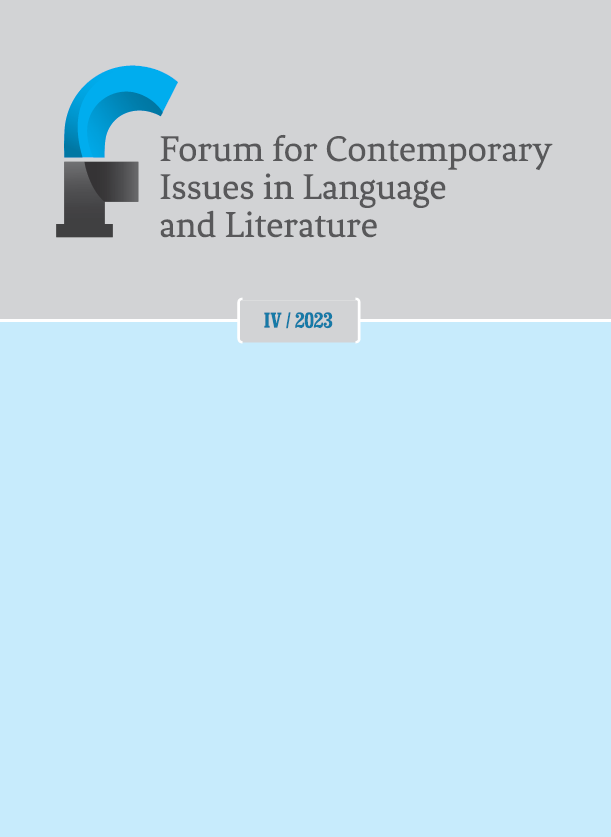Reclaiming Queer Time: Queer Temporalities in Ali Smith’s "How to be Both"
DOI:
https://doi.org/10.34739/fci.2023.04.06Keywords:
Queer Temporalities, Queer Time, Non-linearity, Queer Narrative, Queer Studies, LGBTQIA+ IdentityAbstract
This article examines the different manifestations of alternative temporalities in Ali Smith’s Goldsmiths Award novel How to be Both (2014). My argument is that the novel ‘queers’ understandings of time in two significant ways: by highlighting new possibilities of narrative structure that challenge linear conceptions of time and by questioning regulated notions of developmental temporalities in terms of progression from childhood to heteronormative adulthood. Hence, by drawing on the compelling framework of queer temporalities, the main goal of this article is to analyze the mechanisms deployed by Ali Smith to generate unprecedented configurations of queer time.
Downloads
References
Andermahr, Sonya. 2018. “Both/And Aesthetics: Gender, Art, and Language in Brigid Brophy’s In Transit and Ali Smith’s How to Be Both.” Contemporary Women’s Writing, vol. 12, no. 2, 248–63.
Barber, Stephen M., and David L. Clark. 2002. “Queer Moments: The Performative Temporalities of Eve Kosofsky Sedgwick.” Regarding Sedgwick: Essays on Queer Culture and Critical Theory, edited by Stephen M. Barber and David L. Clark. Routledge, 1–56.
Bennett, Alice. 2018. Contemporary Fictions of Attention: Reading and Distraction in the Twenty-First Century. London: Bloomsbury Academic.
Bilge, Fatma. 2019. “Dual Narratives and Multiple Points of View in Ali Smith’s How to Be Both.” Gaziantep University Journal of Social Sciences, vol. 18, no. IDEA Special Issue, 113–21.
Dinshaw, Carolyn. 2012. How Soon Is Now?: Medieval Texts, Amateur Readers, and the Queerness of Time. Durham: Duke UP
Foucault, Michel. 2000. “Lives of Infamous Men.” Power: Essential Works of Focault, 1954-1984, edited by James D.Faubion. New York Press, 157-175.
Freccero, Carla. 2015. “The Queer Time of Lesbian Literature: History and Temporality.” The Cambridge Companion to Lesbian Literature, edited by Jodie Medd, Cambridge: Cambridge University Press, 19–31.
Freeman, Elizabeth. et al. 2007. “Theorizing Queer Temporalities.” GLQ: A Journal of Lesbian and Gay Studies, vol. 13, no. 2–3, 177–95.
---. 2010. Time Binds: Queer Temporalities, Queer Histories. Durham: Duke UP.
---. 2022. “Together in Time.” Interview by Amelia Groom. Prospections, 21 April 2022, https://www.bakonline.org/prospections/together-in-time-elizabeth-freeman-interviewed-by-amelia-groom/.
Gérmana, Monica, and Emily Horton. 2013. Ali Smith: Contemporary Critical Perspectives. London: Bloomsbury Publishing
Gilbert, Sophie. 2014. “The Artful Duality of Ali Smith's How To Be Both.” The Atlantic, 3 December 2014, https://www.theatlantic.com/entertainment/archive/2014/12/the-artful-duality-of-how-to-be-both/383349/
Haffey, Kate. 2019. Literary Modernism, Queer Temporality: Eddies in Time. London: Palgrave Macmillan.
Halberstam, Jack. 2005. In a Queer Time and Place: Transgender Bodies, Subcultural Lives. Miami: NU Press.
Huber, Irmtraud. 2016. Present Tense Narration in Contemporary Fiction: A Narratological Overview. London: Palgrave Macmillan.
Ranger, Holly. 2019. “Ali Smith and Ovid.” International Journal of the Classical Tradition, vol. 26, no. 4, 397–416.
Sedgwick, Eve K. 1993. Tendencies. Durham: Duke UP.
Smith, Ali. 2014. How to Be Both. London: Penguin Books.
Smith, Ali. 2015. “‘It's about time, love and how we're all connected’ - hear writer Ali Smith talk about her unusual time-shifting novel How to Be Both.” BBC World Book Club, 4 June 2015, https://www.facebook.com/bbcworldbookclub/videos/its-about-time-love-and-how-were-all-connected-hear-writer-ali-smith-talk-about-/10153360064839709/ .
Andermahr, Sonya. 2018. “Both/And Aesthetics: Gender, Art, and Language in Brigid Brophy’s In Transit and Ali Smith’s How to Be Both.” Contemporary Women’s Writing, vol. 12, no. 2, 248–63.
Barber, Stephen M., and David L. Clark. 2002. “Queer Moments: The Performative Temporalities of Eve Kosofsky Sedgwick.” Regarding Sedgwick: Essays on Queer Culture and Critical Theory, edited by Stephen M. Barber and David L. Clark. Routledge, 1–56.
Bennett, Alice. 2018. Contemporary Fictions of Attention: Reading and Distraction in the Twenty-First Century. London: Bloomsbury Academic.
Bilge, Fatma. 2019. “Dual Narratives and Multiple Points of View in Ali Smith’s How to Be Both.” Gaziantep University Journal of Social Sciences, vol. 18, no. IDEA Special Issue, 113–21.
Dinshaw, Carolyn. 2012. How Soon Is Now?: Medieval Texts, Amateur Readers, and the Queerness of Time. Durham: Duke UP
Foucault, Michel. 2000. “Lives of Infamous Men.” Power: Essential Works of Focault, 1954-1984, edited by James D.Faubion. New York Press, 157-175.
Freccero, Carla. 2015. “The Queer Time of Lesbian Literature: History and Temporality.” The Cambridge Companion to Lesbian Literature, edited by Jodie Medd, Cambridge: Cambridge University Press, 19–31.
Freeman, Elizabeth. et al. 2007. “Theorizing Queer Temporalities.” GLQ: A Journal of Lesbian and Gay Studies, vol. 13, no. 2–3, 177–95.
---. 2010. Time Binds: Queer Temporalities, Queer Histories. Durham: Duke UP.
---. 2022. “Together in Time.” Interview by Amelia Groom. Prospections, 21 April 2022, https://www.bakonline.org/prospections/together-in-time-elizabeth-freeman-interviewed-by-amelia-groom/.
Gérmana, Monica, and Emily Horton. 2013. Ali Smith: Contemporary Critical Perspectives. London: Bloomsbury Publishing
Gilbert, Sophie. 2014. “The Artful Duality of Ali Smith's How To Be Both.” The Atlantic, 3 December 2014, https://www.theatlantic.com/entertainment/archive/2014/12/the-artful-duality-of-how-to-be-both/383349/
Haffey, Kate. 2019. Literary Modernism, Queer Temporality: Eddies in Time. London: Palgrave Macmillan.
Halberstam, Jack. 2005. In a Queer Time and Place: Transgender Bodies, Subcultural Lives. Miami: NU Press.
Huber, Irmtraud. 2016. Present Tense Narration in Contemporary Fiction: A Narratological Overview. London: Palgrave Macmillan.
Ranger, Holly. 2019. “Ali Smith and Ovid.” International Journal of the Classical Tradition, vol. 26, no. 4, 397–416.
Sedgwick, Eve K. 1993. Tendencies. Durham: Duke UP.
Smith, Ali. 2014. How to Be Both. London: Penguin Books.
Smith, Ali. 2015. “‘It's about time, love and how we're all connected’ - hear writer Ali Smith talk about her unusual time-shifting novel How to Be Both.” BBC World Book Club, 4 June 2015, https://www.facebook.com/bbcworldbookclub/videos/its-about-time-love-and-how-were-all-connected-hear-writer-ali-smith-talk-about-/10153360064839709/ .
Downloads
Published
Versions
- 18.03.2024 (3)
- 04.03.2024 (2)
- 27.12.2023 (1)
Issue
Section
License
Copyright (c) 2023 Forum for Contemporary Issues in Language and Literature

This work is licensed under a Creative Commons Attribution-NonCommercial-NoDerivatives 4.0 International License.




